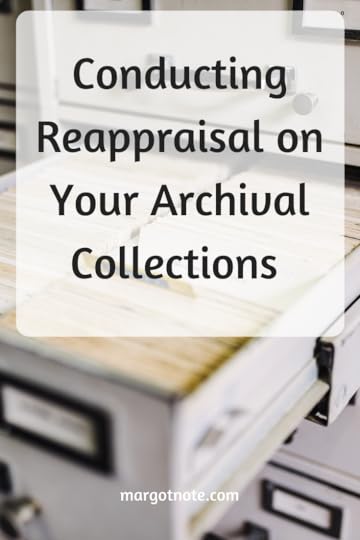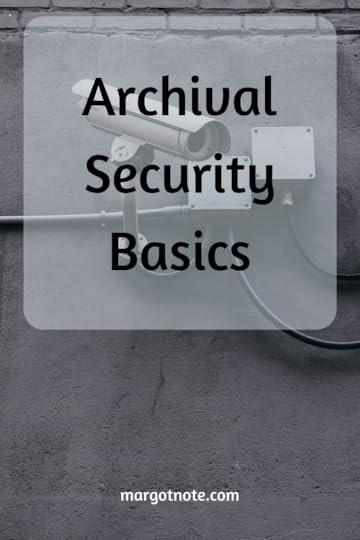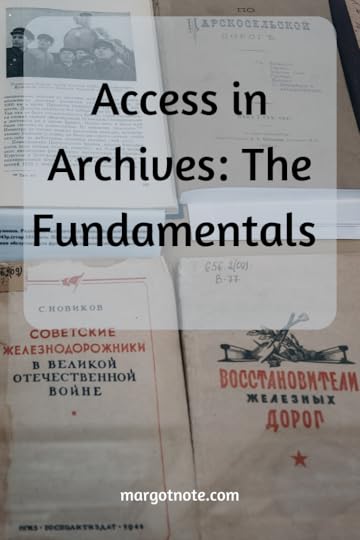Margot Note's Blog, page 27
October 12, 2020
Guide Your Research with Questions
When researching, it’s easy to get caught up in the process, tracking down as much information that you can find. Scholars, though, don’t document information for its own sake, but to support their research question. By asking the right questions, you can be directed to the information you need to answer them.
Beyond the standard questions of who, what, when, where, how, and why, ask yourself the following:
How does my topic fit into a broader context? Why did it come into being?
What’s the subject’s history? How and why has the topic itself changed over time? You may need to create a historiography, the study of the ways history was written, to answer these questions.
How does the subject fit into the larger structure of function as part of a more extensive system?
How can your topic be grouped into similar ideas?
How can it be differentiated?
How would things be different if your topic never existed or disappeared?
What would happen if your topic was put in a new context?
Once you’ve read more on your subject, you may ask questions suggested by your sources:
Ask questions that build on agreement. How does a claim by a source support the evidence that you’ve found from other sources?
Ask questions that reflect disagreement. What have you found that you disagree with? What sources contradict each other, and how do you explain the difference in findings?
As you query your topic, write about it along the way. Write summaries, critiques, questions, and responses to your sources. You may wish to keep a journal to reflect on your progress. Writing helps you understand your subject and what you’ve read about it so far, but it also stimulates your thinking about it.
With these tips in mind, you can interrogate your subject as you research. The questions you use will lead to other questions, and, in time, to clarity on your research topic.
What questions do you use to guide your research? Let me know in the comment section below.
Follow me on Pinterest | Instagram | Twitter | LinkedIn |
If you like archives, memory, and legacy as much as I do, you might consider signing up for my email list. Every few weeks I send out a newsletter with new articles and exclusive content for readers. It’s basically my way of keeping in touch with you and letting you know what’s going on. Your information is protected and I never spam.

October 5, 2020
Conducting Reappraisal on Your Archival Collections
The Society of American Archives defines reappraisal as “the process of identifying materials that no longer merit preservation and that are candidates for deaccessioning”. Archivists continue to seek ways to accomplish responsible reappraisal and deaccessioning.
There are numerous articles, case studies, policies, and conference sessions on reappraisal and deaccessioning, yet despite the increasing amount of information, these practices remain controversial.
When is Reappraisal Appropriate?Archivists may conduct reappraisal when the original appraisal was erroneous, the standards have changed since the collection was acquired, or the historical value of the material has changed over time. In my consulting practice, I’ve found that often no appraisal took place at the time of acquisition, especially when professional archivists didn’t manage the archives or when space wasn’t at a premium. No matter what the reason for conducting reappraisal, it should be systematic and nuanced, and is often expensive and time-consuming.
Can You Reappraise if You Never Appraised in the First Place?Far too often what archivists have in their stacks was never appraised before acquisition, so using the term “reappraisal” is a misnomer. Reappraisal refers to appraising materials that are already part of a repository’s holdings, rather than something we are contemplating acquiring. Appraisal or reappraisal may occur at many stages in archival collections management, ranging from acquisition to accessioning to processing.
And in some cases, archivists take records they do not want in order to get materials that they do. When acquiring collections, sometimes what the donor considers archival-worthy may not be, but for the repository to receive the collection, they may have to take it all. Later, the archivist can prioritize processing to meaningful parts of the collection, while deciding later how to handle the more mediocre series.
Questions to AskIn his oft-cited article, “No Grandfather Clause: Reappraising Accessioned Records,” archivist Leonard Rapport posits that reappraisal can be necessary, ethical, and appropriate. He poses a series of questions that archivists should ask when considering reappraising materials:
Would we acquire these materials if they were offered today?
Is there a reasonable expectation that anyone with a serious purpose will look for these records?
Will scholarship suffer if these records no longer exist?
Rapport implies that the purpose of reexamination is based more on issues of evidential value or the need to provide evidence of stewardship. Although he was talking about reappraising public records, consider applying the same ideas to papers, manuscripts, and other records.
A CounterargumentArchivist Karen Benedict counters Rapport’s arguments in the classic article, “Invitation to a Bonfire: Reappraisal and Deaccessioning of Records as Collection Management Tools in an Archives—A Reply to Leonard Rapport.” She urges that archivists should also consider these questions during reappraisal:
Is use a basis for reappraisal?
How effective is reappraisal in terms of expenditure of time and resources?
Why is a second decision any more accurate than the first?
How will donors react?
Proceed with CautionNo matter where you stand on reappraisal, remember that like anything else in archives, it should be done thoughtfully. Reappraisal requires a defined mission, a collecting policy, and appraisal guidelines. It shouldn’t be performed in an ad hoc or haphazard manner; it should be done systematically to ensure consistency, proper documentation, and ethical practice. Reappraisal requires transparency, accountability, and trust so that stakeholders may better understand archival practices. It may be performed when related records are examined as part of considering new acquisitions. A relative focus on controlling growth versus reducing current holdings should be a factor too.
Reappraisal is most appropriate when the original appraisal was deemed faulty or incomplete. Reappraisal doesn’t always lead to deaccessioning but is required as a first step towards the act of deaccessioning.
The blog was originally published on Lucidea's blog.
If you like archives, memory, and legacy as much as I do, you might consider signing up for my email list. Every few weeks I send out a newsletter with new articles and exclusive content for readers. It’s basically my way of keeping in touch with you and letting you know what’s going on. Your information is protected and I never spam.
Follow me on Pinterest | Instagram | Twitter | LinkedIn | Facebook

September 28, 2020
Public Service Fundamentals for Archivists
Along with reference and access, archivists perform several public service activities to bring collections to interested researchers. For novice users, archival repositories can be intimidating, with rules and policies which may not at first make sense. Helping patrons find archival holdings relevant to their search includes a review of a number of service responsibilities.
Unprocessed CollectionsArchivists have long argued the pros and cons of letting researchers use unprocessed collections—because they haven’t thoroughly scanned the items for confidential material, conservation issues, or other problems. Archivists use the activities of processing to examine and organize materials for research use; doing so allows them to identify and describe materials and create tools like finding aids that will help researches locate materials. Each repository balances the risks of opening collections for which the archives has little physical and intellectual control against the inaccessibility of holdings due to backlogs.
RestrictionsThere are several restrictions that archivists uphold. Donors establish restrictions as part of their deed of gift, and additional sensitive issues may happen during processing. Confidentiality issues may arise in unexpected ways, so the archivist must be sensitive to how researchers will engage with their materials. Boxes, folders, and finding aids should be appropriately marked, so restricted materials aren’t accidentally accessed. No matter what the restrictions are, they must be clear, concise, easy to follow, and consistently enforced.
FeesRepositories need to have both policies and procedures in terms of when fees are appropriate and when they’re not. Some archival repositories charge fees for entrance or use. These are more difficult to justify in public rather than private institutions and can incur the wrath of donors and users. Smaller repositories, especially local historical societies, may have no other way to offset costs. However, fees are generally appropriate for special services, such as copying.
CopyingMost archives do provide copies or digital scans of materials, within reason. Researchers consider this activity part of public service. Copying discourages theft; the repository saves the request form as a record of use in case materials go missing later. However, wholesale copying is time-consuming on the part of the archival staff. Some feel the existence of a copy dilutes the value of the original; there’s a loss of control and the potential for damage. Copying or digitizing fragile materials is best done by staff. If researchers request copies, the copies should bear a copyright warning.
PublicationThere’s a distinction between permission to use, permission to copy, and permission to publish. Sometimes the repository has a copyright of the desired items; more often, it doesn’t—or may to some parts of a collection and not others. The deed of gift should spell out what the donor transferred, but the donor can only transfer the copyright that he or she has. Repositories often advise researchers that they must determine the copyright status themselves.
Some believe that repositories have the right to demand that researchers request permission to reproduce materials in a publication regardless of copyright. Then the archivist can advise the researcher how to cite so that the citation can lead to the material when the next person searches. Citations also help the archives to know how researchers use their collections.
A Service IndustryWorking as an archivist requires customer service skills. Archivists have a broad, yet deep knowledge about the records that they manage. Preserving materials and using research and analysis skills while simultaneously providing access allows history to be made. Access to volumes of documents and engagement with their contents brings more significant meaning to the stories we tell with records of enduring value. Public services in archives offer users a better research experience towards their discoveries.
The blog was originally published on Lucidea's blog.
If you like archives, memory, and legacy as much as I do, you might consider signing up for my email list. Every few weeks I send out a newsletter with new articles and exclusive content for readers. It’s basically my way of keeping in touch with you and letting you know what’s going on. Your information is protected and I never spam.
Follow me on Pinterest | Instagram | Twitter | LinkedIn | Facebook

September 21, 2020
Archival Security Basics
Security at archival repositories balances threats against assets and setting up protections that make materials accessible while protecting as much as possible. Overall, archives are safe places to work and research, yet issues exist.
Natural threats are easy to identify and are relatively straightforward to mitigate; they include fire, floods, temperature and humidity fluctuations, insects, and dust.
Theft, Loss, and NeglectHowever, human threats, like theft, loss, and neglect, are harder to manage. While trust is essential, archivists cannot screen staff members or researchers sufficiently to eliminate all threats. Staff members are, unfortunately, frequently responsible for theft. People steal for monetary reasons, impulse, sentiment, the fear that others are getting ahead in their research, the notion that they are only borrowing, and the desire to purge the historical record of damaging information.
Archivists, understandably, are reluctant to publicize losses of the historical record in general and even more so when the offender is a colleague. News of significant incidents usually occurs through the mass press, which further sullies the profession. Since the field is hesitant to talk about the problem, archivists are unaware of the full extent of it and are uninformed of the range of activities they may perform to curtail theft.
One way to look at security is to identify assets and threats in terms of public and restricted areas and to set up systems accordingly. Archivists at the department-head level, as well as administrators and managers with a level of authority, can then modify their procedures and policies to reduce opportunities for theft, loss, and neglect. Thus, security becomes a management issue rather than purely a preservation one.
Locking Down LocationsStacks and storage areas should be separate from work or public spaces, with controlled access. Archivists should segregate valuable items in locked areas within the stacks. Items may also be removed from collections for separate storage with photocopies in place of the originals in the box. Some archives have a schedule for checking valuable items, making sure they’re still present.
Work areas contain furniture, equipment, and files. They have increased traffic and the presence of non-archivists. Because this area offers entry to a broad group of people, without the visibility of a reading room, access should be controlled and lockable.
In the reading room and other public areas, threats increase, especially if there are exhibits that bring in members of the public who haven’t gone through the researcher screening process. Archives control access, providing places for people to store their belongings, and a physical layout of the spaces that ensures good site lines.
Being AwareArchivists also control what researchers have access to, limiting quantities, paying attention to the use of unprocessed or valuable material, and controlling times when items are out of the archives for preservation purposes or exhibition. The size of archival collections, as well as their description at the folder- or box-level, precludes item-by-item identification. Archivists rarely count every item before and after use, but selected files may require this activity.
Security concerns from a management perspective also mean controlling when maintenance people are in the areas, and making sure staff members know what to do in case of theft or emergencies, including knowing local laws, and the location of exits, alarms, and water valves.
Smart and SafeNothing is foolproof. A secure archives has administrative policies in place and presents an appearance of vigilance. Unfortunately, theft has plagued the keepers of irreplaceable documents for decades, and archival assets will always need security procedures. Using common sense, archivists can take concerted preventative measures to protect materials from the human threats from inside and outside the institution.
The blog was originally published on Lucidea's blog.
If you like archives, memory, and legacy as much as I do, you might consider signing up for my email list. Every few weeks I send out a newsletter with new articles and exclusive content for readers. It’s basically my way of keeping in touch with you and letting you know what’s going on. Your information is protected and I never spam.
Follow me on Pinterest | Instagram | Twitter | LinkedIn | Facebook

September 14, 2020
Disaster and Preservation Planning for Archives
Most archivists recognize that they need to plan for disasters, yet many repositories never conduct proper emergency and preservation planning. Even if they do develop a plan, it often is never updated or utilized.
The lack of foresight is due in part to the complexity of disaster planning, which involves many people, offices, and facilities outside of the archives department. In addition, archivists often work in understaffed and underfunded repositories, focused on the day-to-day operational activities. They may not have the opportunity to strategically plan for the worst—until it’s too late.
Creating a Disaster PlanThe first action in creating a disaster plan is to identify risks. Archivists should look at the risks to their collections in terms of building issues, such as the site terrain, if the basement is above the flood line, electrical and plumbing issues, heating, ventilation, and air conditioning (HVAC) systems, the roof, and fire suppression systems.
It’s also essential to set priorities. Of course, people come first. Then, identify objects that would be vulnerable to threats. Archivists should review collections to determine the valuable objects that they hold.
Consider how to decrease risks. The best protection for archival materials is a cool, dry, and stable environment of moderate temperature and relative humidity with little fluctuation. Clean air and air circulation, no natural or fluorescent light, and good housekeeping are also necessary. Routine building inspections, shifting materials to other locations, regular maintenance and repair schedules, the installation of fire suppression systems, better recordkeeping, improved housekeeping procedures, and other security measures should be reviewed. The off-site storage of vital records or their surrogates and data backups provide business continuity during and after an emergency.
In addition, regular institutional routines with cooperation among the different units of the institution need to integrate planning. The departments must address all kinds of potential emergencies that could happen at the repository.
Next, identify and secure resources. Supplies such as drop cloths, sponges, flashlights, rubber gloves, mops, and buckets should be stored in a marked location. Create an easily accessible list of emergency numbers for both staff members and outside vendors that could help. Reach out for other technical assistance, such as a contract with a freeze-dry company in case flooding happens.
Writing the Disaster PlanDisaster, response, and recovery plans often contain different information for different scenarios.
A plan should contain the following elements:
Introduction
Actions to be taken if there’s an advance warning
First response procedures, such as who to contact when problems arise
Emergency procedures
Rehabilitation plans for getting the repository back to normal after a disaster and prioritizing materials for treatment
Appendices including telephone numbers of employees and recovery services, alarms, locations of keys, floor plans, insurance information, priorities, and other essential information
After the plan is written, it must be maintained and updated, as necessary. People should be aware of where the plan is. A copy should be stored offsite, with signs relaying contact information and emergency responses. A preservation officer for the repository should be appointed.
Preservation PlanningAt the same time as disaster planning, it’s wise to plan for preservation risks to the collection. Calculate the risks to the collections by gathering reliable data through tools such as surveys related to object conditions, the environment, and protective systems and practices. Also, consider how the staff can perform preventive preservation.
Determine the value of the collections, especially the breadth and depth of the holdings. Archivists should identify valuable items or those at risk.
Once those activities are completed, archivists should identify available resources, based on the information gathered on the condition of collections, the environment, factors related to the housings of the materials, and the value of collections.
Plan AheadArchivists should take the time to become informed on disaster planning, response, and recovery, as well as necessary preservation needs—before an emergency strikes. Recovering from and mitigating the impact of an unexpected interruption of operations requires forethought to develop policies and procedures, but that effort is well-invested for the sustainability of the historical record.
The blog was originally published on Lucidea's blog.
If you like archives, memory, and legacy as much as I do, you might consider signing up for my email list. Every few weeks I send out a newsletter with new articles and exclusive content for readers. It’s basically my way of keeping in touch with you and letting you know what’s going on. Your information is protected and I never spam.
Follow me on Pinterest | Instagram | Twitter | LinkedIn | Facebook

September 7, 2020
Reference for Archives
Reference and access, two important areas of public services, are tied to all the activities that archivists perform.
Archivists prepare materials for use according to archival theory and practice; they treat materials like aggregates, arrange and describe them, and make finding aids. Archivists provide initial access through these surrogates, rather than sending researchers to the stacks to browse through the collections. Instead, archivists search within the descriptive tools themselves.
Archivists have a dual responsibility. They both collect and preserve historic resources. A professional conflict for archivists is how to strike a balance between the two. As always, with all archival matters, the level of reference depends on resources, audiences, and other factors.
Defining ReferenceReference refers to the activities by which archivists bring the users and primary sources together. These activities include aiding in person, by mail, telephone, fax, email, or virtually. Reference services may be offered through public programs both within and outside of the repository or offered by lone arrangers, reference departments in larger repositories, or in some repositories, by subject specialists. Professional and paraprofessional staff may perform reference duties. Another option combines locating materials and helping researchers use them, which implies that the archivist is familiar with the subjects in the collections and knows how to perform research within them.
The Reference InterviewThe reference interview at an archival repository usually has three stages. The first is query abstraction, where the archivist and researcher translate the query into a series of topics. The next is resolution, where they both relate the subject to records. Lastly, refinement is the state where the researcher refines the queries and topics, adds the names of organizations, people, and events that they discovered, and then repeats the process. Unlike reference interviews in libraries, reference questions in an archives are more likely to result in a search strategy than a specific answer.
Archival UsersA repository’s audiences are, as always, an essential factor for reference services. Archivists distinguish between internal and outside users, as well as their expertise. For example, genealogists, fellow employees, scholars, and high school students embody different skills and expectations.
Archivists need to understand their current audiences—not just their satisfaction, but their information-seeking behavior, which includes how they approach the materials and how they use the finding aids. Archivists must also think about potential audiences and whom they would like to attract.
Users may be direct or indirect. Direct users are those who obtain information from the repository, such as someone who calls or writes. Direct use, for example, could be administrative use of institutional archives or research use from outside. Indirect users are people who benefit from the archival holdings without ever actually coming into a repository, because a movie, exhibition, legal brief, genealogy, or other activities transmitted primary source information. Think how many people have benefited from a documentary or podcast that used archival materials in their storytelling. The proliferation of content on the web complicates matters. How does one categorize researchers who have used materials digitally, but have never visited the archives?
Archivists make several assumptions about researchers concerning reference. They assume users have done preliminary research before coming to the archives. They also expect that they will be able to link names and subjects since it’s easier to provide access to the former than the latter. They hope that researchers are willing to review aggregate collections since item-level access is so rare. As archivists, we must educate our patrons, especially novice users, on how to use archival holdings and make them feel comfortable.
At Your ServiceArchives exist to serve researchers. An archival repository can have state-of-the-art facilities, brilliantly processed collections, and knowledgeable staff. If the archival collections aren’t being used—by a variety of researchers working on an array of projects—all that strategy and talent is for naught. Reference is the process of connecting users to the primary sources that can answer their research questions.
The blog was originally published on Lucidea's blog.
If you like archives, memory, and legacy as much as I do, you might consider signing up for my email list. Every few weeks I send out a newsletter with new articles and exclusive content for readers. It’s basically my way of keeping in touch with you and letting you know what’s going on. Your information is protected and I never spam.
Follow me on Pinterest | Instagram | Twitter | LinkedIn | Facebook

August 31, 2020
Access in Archives: the Fundamentals
Archives exist to be used by researchers. Access is a set of activities that links primary source materials to the public. Archivists should be able to answer questions about specific collections, such as their sizes, date ranges, the existence of correspondence by individuals, research restrictions, and copyright status, among other issues.
As custodians of records, archivists support transparency and openness, yet respect restrictions required by the law, professional ethics, and donor requirements. Archivists provide information about the repository, as well as information governing the use of the collections it preserves, which an access policy reflects. The policy should provide information about the restrictions in a way that’s clear and limited in scope and duration. Archivists ensure that restrictions are fairly applied to all users, avert unauthorized access, and offer the broadest use of archives by removing unwarranted hurdles to access.
Defining AccessAccess may be defined in three ways:
Intellectual access is the theoretical aspect of how people seek and use materials, which include the arrangement and description of holdings, a variety of finding aids, and the methods of aiding, such as the reference interview.
Legal access has roots in the repository’s legal status with the materials, including the permission to use them, issues of confidentiality and open records, ethics, copyright, and reproduction.
Lastly, physical access means providing the opportunity to examine documents, including reading room procedures and security.
Providing access to archival materials is more complicated than for books, for example, because the diverse formats and subjects included in collections preclude simple descriptions or cataloging for a variety of reasons. The relationships among items within archival groupings are complex. Item-by-item access is often impossible and unnecessary. The research possibilities for a given body of materials may be broad so that various users can differently approach the collection. In addition, some researchers search for broad concepts while others seek specific facts.
Intellectual AccessSome thought leaders have suggested that there’s a tendency towards more fact-based research, where researchers are looking for bits of information rather than wading through quantities of material to synthesize. Genealogists are an excellent example of this phenomenon. Archivists tend to provide information about collections rather than from collections. Archivists need to strike a balance between providing access and doing the scholars’ work for them.
One stubborn issue is that archivists have traditionally been better at providing proper names than subject access and expecting researchers to be able to make connections. The archival research process then becomes more dependent on staff intervention if the user hasn’t become familiar with the topic from secondary sources.
Repositories have reference tools that archivists produced over time, some better than others. As a result, there are usually multiple generations of internal findings aids. Legacy finding aids is the term archivists used to describe these older guides. Archivists don’t always have time to bring previously described collections up to current standards of description and access. Even if an archives has excellent standards now, a lot of what archivists must work with is what their predecessors developed under different criteria.
Connecting Users to CollectionsAccess provides users with archival materials, through the repository’s system of reference services. It’s the ability to locate relevant information with descriptive tools. Organizations should open their archives to the greatest extent possible as these materials have significant value for understanding social, economic, religious, community, and personal history. Making archives accessible helps maintain institutional transparency and credibility, improves understanding of the organization’s history and contributions, and enhances the institution’s profile. The reference process, a collaborative meeting between user and archivist, can hone access to records of enduring value.
The blog was originally published on Lucidea's blog.
If you like archives, memory, and legacy as much as I do, you might consider signing up for my email list. Every few weeks I send out a newsletter with new articles and exclusive content for readers. It’s basically my way of keeping in touch with you and letting you know what’s going on. Your information is protected and I never spam.
Follow me on Pinterest | Instagram | Twitter | LinkedIn | Facebook

August 24, 2020
Digital Preservation Strategies
This is part two of a two-part series on digital preservation for family and personal collections. To learn more, read Creating Family Archives: A Step-by-Step Guide for Saving Your Memories for Future Generations , a manual to help you protect your history easily and economically.
Two fundamental digital preservation strategies are refreshment and migration. These strategies are designed to preserve the integrity of digital items and to enable you to retrieve, display, and use them despite changing technology.
Refreshing involves moving files from one physical storage medium to another to avoid obsolescence or degradation. Because physical storage devices decay, and because technological changes make older storage devices inaccessible to new computers, refreshing is likely to be necessary for years to come.
Migration is more complex. It converts data from one hardware or software configuration to another, or from one generation of computer technology to a subsequent generation while preserving the essential characteristics of the data. In essence, migration is staying ahead of deterioration and obsolescence by copying the data from the old to the current generation of file formats and storage media. Migration gradually brings files into a narrower variety of standard file formats.
Digital preservation places a premium on preserving the integrity of files, but migration inevitably changes data. The files may be changed to make them more suitable for preservation or access. Over time, these changes alter the files. Although this may not affect images, it could affect spreadsheets, for example. Changes in technology over time will affect the usability of the image, sound, and video files you’d like to keep. Every couple of years, you should investigate what upgrades or software changes are needed to ensure that your files are still usable.
Computer files are highly vulnerable, sometimes vanishing forever if equipment fails. Unfortunately, it’s not a matter of if computer equipment will break down, but when. Luckily, most backup systems are high capacity and inexpensive so that you can use more than one method, providing backups in case the first fails. Storage options include external hard drives, which range from portable to larger models. Sharing and backing up of data is done increasingly through online services (known as the cloud) rather than through personal storage devices.
Because technology changes so rapidly, it’s difficult to suggest specific software to use to store your digital collections. For some collections, it may be enough to keep your materials arranged in a file and folder scheme on your computer and backups; or you may wish to organize your materials in Excel spreadsheets, Microsoft Access, Photoshop Lightroom, or other programs. If you’re considering these options, consider costs, security, sustainability, and functionality to determine if an online tool or software program is best for you.
Making multiple copies in multiple formats and storing them in multiple locations preserves their content. Diversity in storage formats is vital because no storage device is stable. Abide by the 3-2-1 rule: Make three copies, store two copies in different types of media, and store one copy in a location that is not where you live or work. For example, you might save a copy on your computer, on an external drive, and in online storage.
Without focused attention, any digital collection is at risk of loss. Acting now, and continuing to act, is essential if digital materials are to last into the future.
To learn the preservation secrets used by libraries, archives, and museums to protect their priceless materials (that you can also use for your family heritage items) read my book:
Creating Family Archives: A Step-by-Step Guide to Saving Your Memories for Future Generations
By Margot Note
Buy on Amazon
Ready to get started creating your family archives? Here are some of my favorite products:
Follow me on Pinterest | Instagram | Twitter | LinkedIn | Facebook
Like this post? Never miss an update when you sign up for my newsletter. As a gift to you, you'll receive a free, premium download of my Project Prioritizer. This trusted tool will help you embrace where you are with your collections and start enjoying your family archives more today.

August 17, 2020
Digital Preservation Fundamentals
This is part one of a two-part series on digital preservation for family and personal collections. To learn more, read Creating Family Archives: A Step-by-Step Guide for Saving Your Memories for Future Generations , a manual to help you protect your history easily and economically.
An acute preservation challenge lies in saving digital items. Technology enables us to create, use, and be enriched by information in ways that were unthinkable generations ago. But the same advances that make sharing information so easy also pose some problems. The complexity and diversity of technology is overwhelming, even as storage capacity becomes cheaper. The volume of digital data, unstable storage media, and obsolete hardware and software make the usability of digital items a challenge.
Digital preservation is a series of activities ensuring access to digital materials for as long as necessary. Although we may think that digital files are forever safe, they require continuous management. Unlike a box of photographs in which you can see the images, access to digital files depends on the technology used to view them. Many physical items can sit unused for decades and still be in good condition. Digital files cannot. It is important to manage your files to ensure that they are migrated to newer technologies and remain accessible.
A digital file is binary code—a series of 1s and 0s—written to some form of physical media such as a USB memory stick, a hard drive, disk, or computer server managed by someone else. All digital materials require reading software and are created in formats specific to a given rendering environment. Just like analog media, all forms of digital media face threats and are subject to deterioration at a rate dependent on the inherent properties of the medium and the storage environment.
Bit rot occurs when a digital file decays to the point at which its bits lose their definition, and the file becomes unreadable. And leaving bit rot aside, files are lost or misplaced.
People are shocked by how quickly data begins to deteriorate on consumer storage technology. For example, external hard drives, if stored correctly, might last a decade. If not treated well, they may last only five years. Major changes take place in hardware every couple of years and in software every one to five years. Although the data may be there, the technology to access it may be out of date. Digital resources require diligence.
Keeping files with an internet-based storage service, such as Google, does not guarantee their survival either, although it can be part of a preservation plan. Such companies manage their technology well, but files can be deleted or lost. The terms of service that you signed offer no promises, even if it is possible to download a copy of your data. Consider also digital succession planning when using such services.
Follow these suggestions to keep your digital files accessible:
Survey your collections by gathering disks, drives, and other physical media that contain your files.
Using the information on the labels, if any, note which items might be worth a closer look.
Use available software to try to read files created with older software programs.
Make notes about which files are most significant and why, which ones are inaccessible, and which ones to discard.
Cull your digital files based on the priorities that you determined.
Transfer files from older media to more modern and reliable storage.
Your files should be protected to a level that is proportional to the value of the data and the difficulty in recreating them. The combination of value and replicability will help you to determine the priority that you should place on your files.
To learn the preservation secrets used by libraries, archives, and museums to protect their priceless materials (that you can also use for your family heritage items) read my book:
Creating Family Archives: A Step-by-Step Guide to Saving Your Memories for Future Generations
By Margot Note
Buy on Amazon
Ready to get started creating your family archives? Here are some of my favorite products:
Follow me on Pinterest | Instagram | Twitter | LinkedIn | Facebook
Like this post? Never miss an update when you sign up for my newsletter. As a gift to you, you'll receive a free, premium download of my Project Prioritizer. This trusted tool will help you embrace where you are with your collections and start enjoying your family archives more today.

August 10, 2020
Archival Finding Aids Explained
A finding aid is a term used by archivists to describe the various kinds of written descriptions they produce about collections. An aid can be any descriptive tool: published or unpublished, manual or electronic, produced by the creator, the records management program, or the archival repository.
These guides were captured on paper for years, then were created in Word and Excel documents. Now, they’re frequently encoded using Encoded Archival Description (EAD), a standardized system that allows users to find primary sources more easily.
Finding Aid ElementsFinding aids begin with a title page, which includes the title, dates, repository name, the name of the person who created finding aid, and the date the finding aid was created. If there’s no title page, the beginning of the document contains this information.
The administrative and biographical history provides contextual information in terms of the biography of the person or the history of the organization. It gives an overview, not the complete story, with a focus on the period that the records derived from. The section summarizes the functions, activities, events, and changes that are necessary to understand the materials; this information relates to provenance.
The description section is the explanation of the materials in terms of their contents, arrangement, and physical characteristics. It includes the strengths and weaknesses of the collection and identifies depth and gaps. It can include information on the ways that records were generated and maintained, which is distinct from the administrative and biographical history section. The overall description of the collection is traditionally called the scope and content note. If the collection is extensive, with defined series, an additional narrative describes each series and how those series are arranged.
In the administrative information section, the archivist provides whatever information is necessary to use the collection, such as restrictions or copyright information.
Container and folder lists include the box- and folder-level descriptions of how the files are stored so users can identify what they want to see and gauge the quantities of the materials.
Additional information can include any collateral data that would be useful to researchers, such as a glossary of terms, a bibliography, organizational chart, family tree, or other items.
In some cases, there is further guidance to the collection in the form of an index, such as a list of significant correspondents.
Internal and External GuidesFinding aids fall into two categories: internal and external.
Internal finding aids are usually a combination of catalogs, inventories, lists, and databases produced by or supported by the repository and used inside the repository or on the repository’s intranet. It’s impossible to remember all aspects of a collection, although there will inevitably be information that isn’t written down. Internal finding aids are often distinctive and unique to each repository. For example, in a position I held for an institutional archives, I had created EADs and Word-based finding aids for some collections. I also maintained other collections through an Access database. Someone new to the archives would have difficulty locating materials with this system, but I became a superuser through my frequency of usage and my knowledge of the collections that developed over the years.
The repository or outside parties can issue external finding aids. The purpose of the external guides is to attract researchers. Examples are journal notices, exhibits, online or book guides, or national guides like the National Union Catalog of Manuscript Collections (NUCMC). Finding aids can also be published on websites or shared via the ArchiveGrid interface. These guides usually provide an overview of the collection for an audience new to the materials well as box- or folder-level inventories of the primary sources they describe.
Surrogate to the CollectionSo, what are finding aids? A finding aid acts as a surrogate to the collection. It describes the collection as a whole and provides information on the people and activities that created the collection. It informs researchers about the organization of the collections and points researchers to where they might find material of interest. A finding aid, whatever the format it embodies, provides a valuable key to accessing collections of primary sources.
The blog was originally published on Lucidea's blog.
If you like archives, memory, and legacy as much as I do, you might consider signing up for my email list. Every few weeks I send out a newsletter with new articles and exclusive content for readers. It’s basically my way of keeping in touch with you and letting you know what’s going on. Your information is protected and I never spam.
Follow me on Pinterest | Instagram | Twitter | LinkedIn | Facebook




